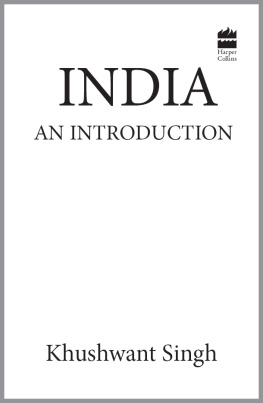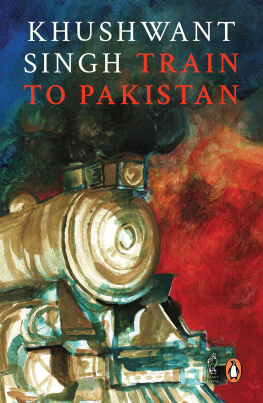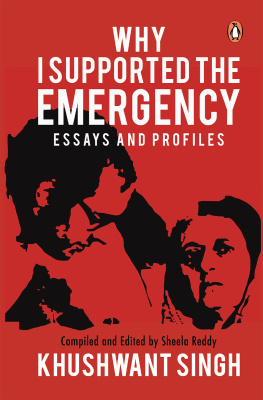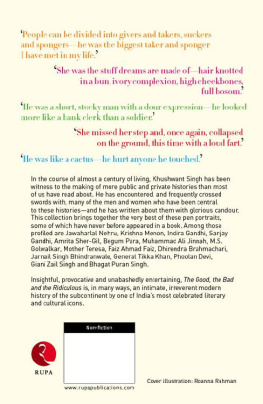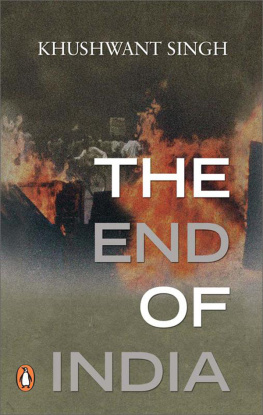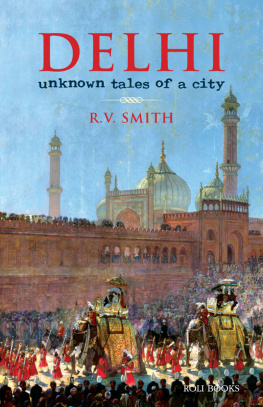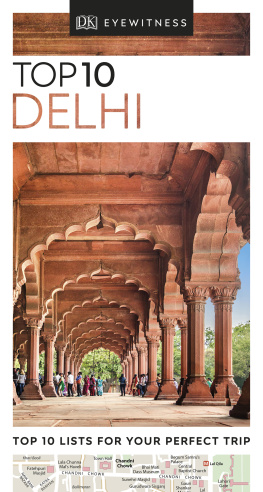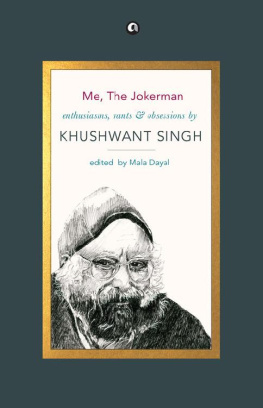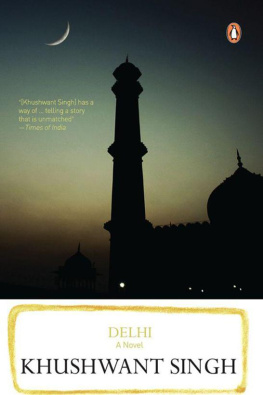Khushwant Singh is one of Indias best-known writers and columnists. He began his career as a journalist with All India Radio in 1951. Since then he has been the editor of the Illustrated Weekly of India, the National Herald and the Hindustan Times for several years. He is also the author of several books, including the novels Train to Pakistan, I Shall Not Hear the Nightingale, Delhi: A Novel and The Company of Women; the classic two-volume History of the Sikhs; as well as numerous translations and non-fiction books on Delhi, nature and current affairs. His autobiography, Truth, Love and a Little Malice, was published in 2002.
Khushwant Singh was a member of Parliament from 1980 to 1986. Among other honours, he was awarded the Padma Bhushan in 1974 by the President of India, but he returned the decoration in 1984 in protest against the Union Governments siege of the Golden Temple in Amritsar.
Introduction: Loving and Loathing Delhi
Some contributors to this anthology, especially the younger writers, wonder if Delhi can ever be anybodys native city. People come here to earn a living, to study, or were born here and so had no option. But if one had a choice, would one really choose to live here? Does this ancient city, once described as the mistress of every conqueror, inspire love or loyalty?
Having spent much of my life in Delhi, I can tell you that there is as much to love about the city as there is to loathe. What is loveable makes a long list, but so does all that is loathsome about it. Let us first look at the things that make Delhi unique among the capitals of the world. It has a longer history and more historical monuments than any other metropolis. Relics uncovered in and around Delhi date well beyond the sixth century BC . As for monuments, you will find one in every square kilometre. It has more mosques, mausolea and memorials than any city in a Muslim country. There are few mosques anywhere that can rival Delhis Jama Masjid in size and grandeur. See it from a distance at sunset on the last day of the month of Ramzan. You will notice people on top of the minarets scouring the gradually darkening sky. If the fine fingernail of the crescent moon is spotted, cries of joy are heard from neighbouring rooftops, a cannon is fired and garlands of white lights frame the perfect outlines of the Royal Mosque. It is a never-to-be-forgotten experience which will even make a non-believer acclaim the glory of GodAllah-o-Akbar!
Another mosque that will stay in a visitors mind is Moti Masjid or Pearl Mosque in the Red Fort. It is as small as the Jama Masjid is big, and very appropriately namedmeant for private worship of the Muslim rulers of Delhi who lived in the marble palace alongside it, it is like a jewel-box of virginal white. There are a dozen others of great architectural beauty but we must not overlook the other Muslim monuments for which Delhi is famous. The best known is the Qutub Minar, raised as a victory tower in the eleventh century AD . It is a slender, tapering edifice of beige and red sandstone, lavishly embellished with verses from the Holy Koran. There are many buildings in the world taller than Delhis Qutub Minar, but few to match its excellence. Then there is the mausoleum of emperor Humayun, built by his widowed empress. Stand at the entrance gate to gaze at the perfect proportions and you will understand why it was chosen as the model for the worlds most beautiful monument, the Taj Mahal in Agra.
Delhi also has many beautiful modern buildings. There is the Rashtrapati Bhawan, the Secretariats, Parliament House, India Gate. You can see them in all their glory in the last week of January, around Republic Day, when they are festooned with lights. For the most splendid view, position yourself at India Gate as the sun goes down over Raisina Hill. It was not the grandeur of the old but the modern city that made Sarojini Naidu exult: Imperial City, dowered with sovereign grace! And it remains grand, though it is no longer imperial, nor has it a sovereign, but a democratic city dowered, hopefully, with secular grace.
More than mans contributions it is natures bounty that has made Delhi the eternal capital of India. A broad river, the Yamuna, second only to the Ganga in sacredness, marked its eastern boundary, and a rocky ridge, the end of the Aravalli range, its western end. Between the river and the ridge rose several cities, each one the seat of the empire of Hindustan. As its population multiplied, it spilt over the river and rocky ridge till it spread over thirty square miles, to become, after Calcutta and Bombay, the third largest city of India. While the buildings came up, nature and man joined hands to add to the citys treasures: Delhi has more trees per square kilometre than any other big city. Most of them grow wild and are the gifts of nature, but a succession of rulers also laid out gardens and orchards wherever they lived. Little remains of these historical gardens besides their names: Hayat Baksh, Qudsia, Roshanara, Mahaldar Khan and others. The most significant contribution was made by the British. When they made blueprints of New Delhi, they provided for extensive planting of trees. As roads were laid out, saplings were planted. They chose massive, shade-giving treesbanyans, neems, jamuns, Arjuns, mahuas, maulsarisso that we now have broad, tree-lined avenues in central Delhi. After Independence, our own rulers opted for quick-growing trees: jacarandas, laburnums, gulmohars and the completely useless eucalypti. However, between the old and the new, there is not a season when one or the other tree is not in full flower. The year starts with the semals (silk cottons) followed by the corals, chorizzias, flame of the forest, jacarandas, amaltas (laburnums), gulmohars and lagerstroenias (jaruls). After a short recess the floral cycle begins to move again.
Delhis greenery contributes to its rich bird life. The Delhi Bird Watching Society has listed almost five hundred distinct species of birds, resident and migratory, which can be seen in and around the city every year. There is never a moment when you look up and do not see flocks of birds circling and streaming across the sky. In the evenings as they go to roost the loud chorus of mynahs and parakeets drowns the roar of traffic. In Delhis bazaars and railway stations cheeky bank mynahs sometimes wriggle their way between peoples feet.
But you dont see that kind of thing as often as you used to. Delhi has become a very polluted and congested city. It has more cars than Bombay, Calcutta and Madras put together. So there is more poison in the air than in other cities. That and the reckless use of pesticides has taken a heavy toll of insect, amphibian and bird life. In the rainy season, no frogs croak, no fireflies or moths are to be seen. Vultures have disappeared, sparrows have become scarce. The incidence of asthma and bronchial ailments has shown an alarming increase, and if residents of Delhi manage to survive it is because of the greenery around them.
The not-so-loveable aspect of Delhi is entirely manmade. Delhiwalas are about the most inconsiderate of the human species you can encounter. They think nothing of throwing their garbage into their neighbours homes or on the road. They observe no road rules and are ever eager to overtake others, blow their horns and get into violent arguments. On an average four to six people are killed every day by cars and buses. About the same number are murdered in cold blood. Thefts and burglaries are a daily feature. Molesting women in buses is a common practice.


